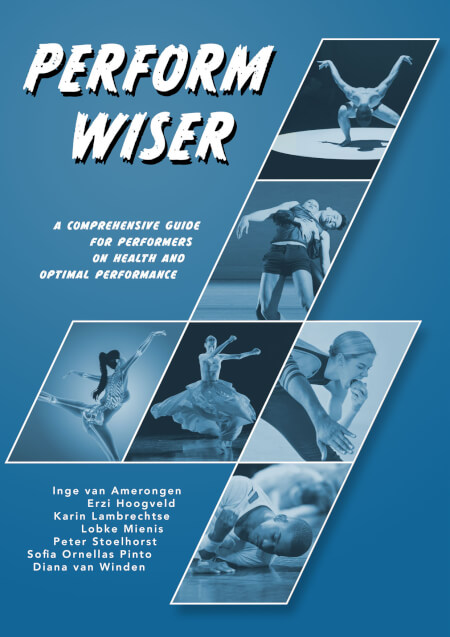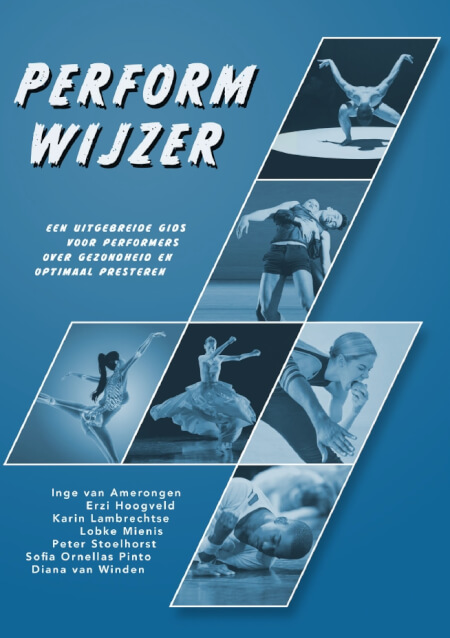Binding : PDF
Auteur : Inge van Amerongen, Erzi Hoogveld, Karin Lambrechtse, Lobke Mienis, Peter Stoelhorst, Sofia Ornellas Pinto, Diana van Winden
Bestandstype : PDF
Distributievorm : Ebook (digitaal)
Aantal pagina's : Afhankelijk van e-reader
Beveiliging : Geen Informatie
Uitgeverij :
Academy for Theatre and Dance Amsterdam & Arnhem
ISBN :
Geen
Datum publicatie : 08-2024

€ 18,95
PRINT boek
niet beschikbaar
ePUB ebook
niet beschikbaar
Perform Wiser
Inge van Amerongen, Erzi Hoogveld, Karin Lambrechtse, Lobke Mienis, Peter Stoelhorst, Sofia Ornellas Pinto, Diana van Winden • ebook • pdf
- Samenvatting
The authors explore the physical and mental challenges faced by performers, taking a holistic approach that considers the whole individual - the interaction between body and mind in achieving your best in a healthy, informed and sustainable way. This textbook is primarily intended for artists/performers who use the body as a (creative) instrument (such as dancers, circus artists, mimers, figure skaters). Additionally, the material can inspire and support professionals from pedagogical and care disciplines.
Parts A and B cover the anatomical structures of the human body. The body is a complex, interconnected whole that we can better understand by first examining its individual components. We start with a discussion of the general structures that make up the body, such as bones, muscles, and fascial tissue. We then delve deeper into how these structures are shaped and function in different parts of the body.
Part C focuses on movement in general. After delving into specific systems such as the fascial system, it is fascinating to explore how this system functions within the entire body. The same applies to the study of different body regions having examined them in detail, we now investigate how they can work together most effectively. This section also covers topics such as motor learning, stretching, and periodisation in physical training.
Part D provides insights into the most common injuries, including strategies for prevention and guidelines for recovery in case an injury occurs.
Part E explores the mental skills you can develop, including goal setting, focus, visualisation, mindfulness, and cognitive training.
Part F, the final section, provides a comprehensive look at the role of nutrition. You will learn why proper nutrition is crucial and what additional dietary needs performers have to achieve optimal performance. This section covers digestion, energy, timing and nutritional challenges such as cramps, exercise-induced headaches, and allergies It also addresses body composition and personalised nutrition, including considerations for vegetarian or vegan diets. - Productinformatie
- Inhoudsopgave
Colofon
Foreword
Introduction - Everything is connected
Acknowledgements
About the authors
Part A: General anatomy
Chapter 1 – The foundation: connective tissue and bones
1.1 How do you build a body?
1.2 Why bones?
1.3 Bone tissue under the microscope
1.4 The bone-building team
1.5 Types of bone tissue
1.6 Bone shapes
1.7 Long bones in more detail
1.8 I feel it in my bones: the periosteum
1.9 Bone growth
1.10 Bones are alive!
1.11 Remodelling? Rather not here...
Chapter 2 – Bending and stretching: your joints
2.1 Why joints?
2.2 Nice and smooth: cartilage
2.3 Joints subdivided
2.4 Additional support: the ligaments
2.5 Shape determines movement : synovial joints subdivided
2.6 Moving: not as simple as you might think…
2.7 Keep it steady
2.8 Keep it flexible, but not too: hypermobility
2.9 A stiff rake: hypomobility
Chapter 3 – An (ex) tensioning topic: your muscles
3.1 The what and why of muscles
3.2 How to build a muscle?
3.3 Tendons
3.4 Control
3.5 Muscles of all shapes and sizes
3.6 Muscle daptation
3.7 Getting tense: types of muscle contractions
3.8 Pump those muscles!
3.9 Red, white and in between: types of muscle fibres
3.10 Movement- and postural muscles
Chapter 4 – Fascinating fascia
4.1 Everything is connected: your fascia
4.2 The fascinating functions of fascia
4.3 Tensegrity
4.4 Failing fascia: how can it go wrong?
4.5 Fascia and (muscle) pain
4.6 Fascia and stress
4.7 Self-care: how can you keep fascia healthy?
Chapter 5 – To get nervous about: your nervous system
5.1 Your personal power grid: the nervous system
5.2 Where is it located? The central and peripheral nervous systems
5.3 What does it do? Functions of the nervous system
5.4 It gets on your nerves: stress
5.5 From outside and inside: sources of stress
5.6 Stress and (anti)social behaviour
5.7 A healthy nervous system: stress and balance
Chapter 6 – Blood and hormones
6.1 A bloody story: your cardiovascular system
6.2 Pumping away! Your heart and blood vessels
6.3 Something light-hearted: your breathing
6.4 Breathe in... breathe out...
6.5 Hormones: your endocrine system
6.6 Take care of your hormones!
Part B: A closer look at the different parts of your body
Chapter 7 – The spine
7.1 Introduction
7.2 Bones
7.3 Special structures
7.4 The different parts of the spine
7.5 Joints and ligaments
7.6 Movements of the spine
7.7 Muscles
Chapter 8 – The pelvis
8.1 Introduction
8.2 Bones
8.3 Joints and ligaments
8.4 Movements of the whole pelvis
8.5 Muscles
Chapter 9 – The hip
9.1 Introduction
9.2 Bones
9.3 Joints and ligaments
9.4 Movements of the hip
9.5 Muscles
Chapter 10 – The knee
10.1 Introduction
10.2 Bones
10.3 Joints and ligaments
10.4 Special structures in and around the knee
10.5 Movements of the knee
10.6 Muscles
Chapter 11 – The ankle and foot
11.1 Introduction
11.2 Bones
11.3 Joints and ligaments
11.4 Movements of the ankle, foot and toes
11.5 The foot arches and plantar fascia
11.6 Muscles
11.7 Foot stability
Chapter 12 – The shoulder
12.1 Introduction
12.2 Bones
12.3 Joints and ligaments
12.4 Movements of the shoulder
12.5 Muscles
Chapter 13 – The elbow, wrist and hand
13.1 Introduction
13.2 Bones
13.3 Joints and ligaments
13.4 Movements of the elbow, wrist and hand
13.5 Muscles
Part C: Movement and movement development
Chapter 14 – Movement
14.1 How do you move? Which poem is being narrated?
14.2 Movement habits and paterns
Chapter 15 – How do you change movement?
15.1 Moving or physical training?
15.2 How to change posture and movementpatterns?
15.3 Starting at the basis
15.4 The knee, the biggest weight of your body
15.5 Your core, the entre of the body
15.6 Feet of the floor
15.7 Arm movement
Chapter 16 – Motor learning
16.1 Representative theories
16.2 Anti representative theories
Chapter 17 – Fitness training
17.1 Warming up and cooling down
17.2 Flexibility
17.3 Proprioception and Balance: how does it work and how do you train it?
17.4 Strength and power training
Chapter 18 – Optimal training
18.1 Load/load ability
18.2 Acute: chronic workload ratio (ACWR)
18.3 Supercompensation and the rest/recovery balance
18.4 Periodisation
18.5 Overloading
Part D: First aid for accidents
Chapter 19 – Injuries, prevention and recovery
19.1 Introduction
19.2 Injuries: acute or gradually occurring
19.3 The stages of recovery
19.4 The recovery of different tissues
19.5 What to do in the event of an acute injury?
19.6 Muscle pain
Chapter 20 – What to do in case of an accident?
20.1 Introduction
20.2 Common accidents
20.3 The first aid suitcase
Part E: Mental skills for performers
Chapter 21 – Introduction
21.1 How important is mental health to your performance?
21.2 The difference between mental dysfunction, functioning and optimal performance
21.3 Characteristics of mental complaints
21.4 Breaking the taboo
21.5 How can you prevent these complaints?
Chapter 22 – Ready, set, go! From goal setting to focus
22.1 Motivation
22.2 Goals, goals, goals
22.3 From goal setting to goal achievement
22.4 Attention!
22.5 Distraction
22.6 Focusplan
Chapter 23 – Stay calm in the spotlight! All about pressure and visualisation
23.1 Relax! Or not?
23.2 Sleep
23.3 Mindfulness
23.4 Breathing
23.5 Mind training
Chapter 24 – Thought training for the performer
24.1 I think...
24.2 'Let it go' (Acceptance and committed action)
24.3 Your (wise) mind
24.4 No hard feelings
24.5 Stumbling is not so bad
24.6 Self-confidence
Chapter 25 – Mental aspects of injury
25.1 Injury risks
25.2 How does an injury influence you?
25.3 Together we can handle more than alone
25.4 Using mental skills
Part F: Nutrition for performers
Chapter 26 – Let's talk food! Basics & balance
26.1 The 6 feeding pillars for performers
26.2 Optimal composition of nutrition for performers: the dance nutrition pyramid
26.3 Nutrition, what does it consist of?
26.4 Macronutrients and energy
26.5 Energy balance
26.6 Calculate your total energy consumption to determine your energy balance
26.7 Keeping a balance sheet
Chapter 27 – Macronutrients, micronutrients and fluids
27.1 Carbohydrates
27.2 Fats
27.3 Proteins
27.4 Macronutrient distribution: what's the best macro ratio for you?
27.5 Micronutrients
27.6 Vitamins - what you need to know
27.7 Minerals - what you need to know
27.8 Water, hydration, and fluid balance
Chapter 28 – Digestion, metabolism and energy systems
28.1 Digestion, metabolism, digestive system, combustion?
28.2 Digestion
28.3 Metabolism & metabolic process
28.4 Combustion, ATP and energy storage in the human body
28.5 The energy systems of the human body
Chapter 29 – Timing of nutrients
29.1 Timing of meals on a rest day
29.2 Timing of meals on a training performance day
29.3 Macronutrient timing
29.4 Fluid balance: drinking before, during and after dancing
29.5 Supplements for performers
Chapter30 – Dance-related nutritional challenges
30.1 Lactic acid, cramping or muscle soreness, do you know the difference?
30.2 Injuries and nutrition
30.3 Allergies / intolerances
30.4 Gastrointestinal complaints during/around exercise
30.5 Vegetarian, vegan, and flexitarian diets for performers
30.6 Stress and tension
30.7 The influence of the menstrual cycle on performance
30.8 Red-S
30.9 Eating disorders
Chapter 31 – Body composition & Personalised nutrition
31.1 What does body composition entail?
31.2 Healthy focus on own body
31.3 Personalised nutrition, make your own nutrition plan!
31.4 Example daymenu's and recepies
31.5 Mealprepping for performers
31.6 Reading labels
31.7 Cooling down: knowledge is your asset, skills are your future
Appendixes
1. Weekly summary template
2. Sample daily menus and meal plans for performers
a. Sample day menu and meal plan Dina
b. Sample meal plan performance company
c. Nutrition timeline example
3. Mealplanner and cooking schedule
a. Sample planner
b. Dance day planner
c. Performance day planner
4. Sample shoppinglist meal prep
5. Recipe ideas for performers - Reviews
(0
uit 0 reviews)
Wil je meer weten over hoe reviews worden verzameld? Lees onze uitleg hier.
€ 18,95
niet beschikbaar
niet beschikbaar
direct, via download
Veilig betalen

Informatie
Herroepingsrecht is uitgesloten voor eBooks. Een download van een eBook of luisterboek is niet meer te herroepen op het moment dat u, na aanschaf van het e-book, de download heeft gestart.


